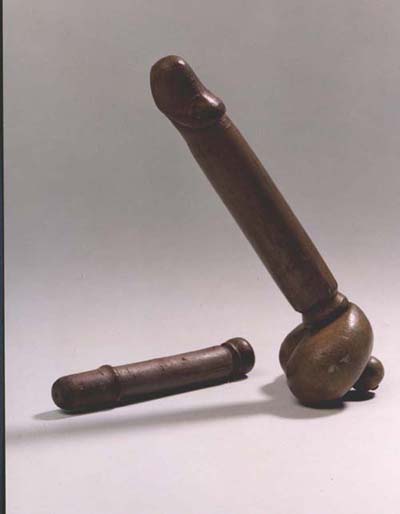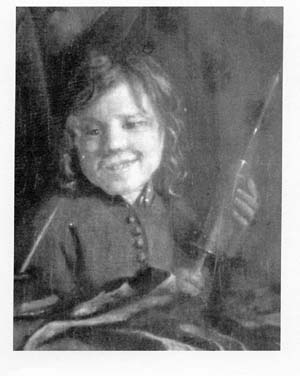V@ginal
syringe*
 The
v@ginal* syringe has as least three
functions as far as we can see at the moment
(see the photo on the right which shows two of these unique objects
recently excavated from a cess pit belonging to a private home in the
town of Zwolle, The Netherlands).
The
v@ginal* syringe has as least three
functions as far as we can see at the moment
(see the photo on the right which shows two of these unique objects
recently excavated from a cess pit belonging to a private home in the
town of Zwolle, The Netherlands).
In the first place the v@ginal syringe was used to flush the
v@gina after lovemaking. This resulted in a simple but not very
effective way of birth control. It was quite a normal household
object according to mr. A. van Dongen of the Boijmans van Beuningen
Museum, Rotterdam. One of his contacts told him of such an object
hanging right in his grandmother's toilet.
In the second place a woman could insert herbal fluids into her
v@gina. Medical doctor Dodoens (alias Dodonaeus), author of the
standard work on herbal medicine Kruidboek or
Kruydt-boeck gives many recipes of v@ginal washes with herbal
fluids, which serve to cure womens' ailments. Culpeper published an
English translation, largely based on Dodoens, including the trick of
making tampons with a little rope.
The construction of both wooden v@ginal syringes are as
follows:

The larger one with its life like shape is 22,5 cm long and has
been crafted from boxwood which has been polished and finished very
smoothly. It consists of four parts. A hollow
pen1s* shaft with thread at the bottom,
allows connection of another part, the balls. The piston can move
within the pen1s shaft and may be secured with a knob at the bottom
end.
The smaller item has a length of about 14,5 cm and its design is
stylized. The type of wood has not yet been determined. It consists
of just two parts, the pen1s schaft and the piston. At the front part
of the piston there is a missing knob.
In the recent publication on this excavation the author of 'Subterranean
Zwolle / 'Zwolle Ondergronds' states that given the high quality of finds
of pot sherds and other objects this cess pit, the house must have belonged
to a member of the municipal elite (Clevis, p. 121).
 A
newspaper article reported on this extraordinary find: " 'At first
I thought they were a couple of adult toys, that we had found some
di1do's', sais mr. H. Clevis, municipal archaeologist from the
town of Zwolle in the eastern part of the Netherlands.' But then
somebody pointed out that these once were common utensils, v@ginal
syringes used to wash out the v@gina.'*
A
newspaper article reported on this extraordinary find: " 'At first
I thought they were a couple of adult toys, that we had found some
di1do's', sais mr. H. Clevis, municipal archaeologist from the
town of Zwolle in the eastern part of the Netherlands.' But then
somebody pointed out that these once were common utensils, v@ginal
syringes used to wash out the v@gina.'*
These syringes have been found in an ancient cesspool in the
old town of Zwolle (The Netherlands). Two wooden tubes from the
seventeenth century, quite unique, for as far as we know these are
the first objects from that era which have been dug up in Western
European soil.
Thus they served to cleanse the v@gina, in particular for
flushing it after having made love, to prevent pregnancy. It is an
old fashioned contraceptive, but not very reliable.
The largest object consists of a hollow, pen1s shaped boxwood
tube of about 22.5 centimeters long with a screw thread at the
back to which the two balls can be attached. At the back side of
this scrotum, which is not functional, is a hole in which a piston
may be moved. At the end of this piston is a knob which serves as
handle. The second object works in the same way, but has been
shaped in a purely functional way, not as life-like as the
first.
'Rinsing with soapy water has been a contraceptic for a long
time', sais mr. K. Grooss, medical historian of Museum Boerhaave
in Leiden. 'It does reduce the chance of pregnancy if the water is
powerfully flushed in. That water will be able to flush out quite
a lot of sperm and hinders the nesting of the egg'. But why did we
find so little of these? 'As they were made of wood and that is a
perishable material, Clevis postulates. 'They were not very
reliable and were little used, Grooss suggests. 'Yet the v@ginal
syringe became quite common in the nineteenth century, made of
Bakelite and being powered by water from a rubber ball which one
could squeeze.' Although it may have been little used there are
some seventeenth century Dutch references to the "vrouwenspuit".
According to Clevis one is shown on a Jan Steen painting entitled
'The Quack'. It shows a woman who is visited by her lover, a man
who is dressed up as a doctor. A boy, grinning widely, holds a
v@ginal syringe. Would the v@ginal syringes from Zwolle have
another function than the cleansing one? Clevis: 'Anything I would
try to say about that would be made up'."
 These
two extraordinary objects are now permanently on show in the
Municipal (Stedelijk) Museum, Zwolle, The Netherlands. Photo
copyright Westerink Fotografie, Zwolle.
These
two extraordinary objects are now permanently on show in the
Municipal (Stedelijk) Museum, Zwolle, The Netherlands. Photo
copyright Westerink Fotografie, Zwolle.
The detail of the painting with a boy holding a v@ginal syringe is
from a Jan Steen painting in the Boijmans van Beuningen Museum,
Rotterdam.
Literature: Hemmy Clevis, Zwolle Ondergronds, Zeven blikvangers
van archeologische vondsten in Zwolle, published by Stichting
Promotie Archeologie, Zwolle, no year [2001?]. pp.
119-120.
Original text of newspaper
article from NRC Handelsblad (?) summer 2001. Who knows the
right source?
Translation by Kees Kaldenbach,
2002.
Men and women, if they chose to do so, could perform birth control by obtaining
certain herbs from the apothecary. "If the apothecary would not provide certain
herbs, a lot of children would be born." [ Dutch:"Waerder inde apteeck
gheen heymelick cruytt, wat zouder menigh kinnercken comen uyt"] was
a naughty rhyme once written by a citizen. (Ach lieve
tijd, Delft, 1995, p. 12).
=======================
New:
V@ginal stimulation by doctors and midwives.
More details about the tasks of a midwife can be found in Catherine Blackledge,
The Story of V, London, Weidenfeld and Nicholson. I have taken the
following information from the Dutch translation, especially pages 273 + 291
+ 345.
(here I insertthe 1 and the @ so that this page will
not be blocked by Internet filters).
Stimulating and vibrating the v@gina was considered a normal task for medical
doctors from the times of antiquity onwards. Doctors wrote quite openly about
this practice, see for instance in the descriptions in books by Galenus / Galen
who lived from 129-200 after Chr and in books by Äetius of Amida, who lived
from 502-575). Well into the seventeenth century, medical men remained convinced
that retaining semen in the human body for too long was bad for health, not
only for men but also for women. Women were understood to produce and retain
semen as well, especially when they were virgins or recently widowed - and thus
they were prone to show signs of nervous disorders because of it. In order to
relieve tension in these women, doctors or later on midwives would perform manual
stimulation of the v@gina so that org@sm would result in a flow of v@ginal fluid,
taking the female 'semen' along. Midwives would also use nicely perfumed oils
on the inside of the v@gina and would insert pen1s
like objects into the vagina. In order to combat 'hysteria' doctors also advised
married nervous women to make love to their husbands more often. (Blackledge,
page 273). However this medical practice of vaginal stimulation was increasingly
frowned upon at the end of the seventeenth century.
Seventeenth century doctors increasingly preferred to leave this manual task
to midwives who gained quite a new field of expertise: "Let midwives anoint
her fingers with [...] young mackarel mixed with musk, ambergris, civet and
other sweet powders, and let them rub and tickle the top of the tube towards
the womb, reaching the inner opening."
Another theory was the result of the belief that the uterus (womb) was moving
freely about in the belly region and even upwards towards the throat region.
All of this walking about could lead to suffocation of the womb, referred to
as 'hysteria'. In order to remedy this, sweet scenting aromatic oils were inserted
in the v@gina to lure the womb back down. Herbs (ginger, laurel) were also burnt
and their fumes were released inside the v@gina after inserting a hollow metal
fumigating instrument, shaped like a pen1s, with sieve holes. (Blackledge, illustration,
page 290).
See the discussion of seventeenth century v@ginal syringes
(Here I use the 1 and the @ so that this page will not
be blocked by politically correct Internet filters).
This object does NOT form part of the
Vermeer inventory. It serves here to shed light on in seventeenth
century Dutch practices in sexuality and birth control.
On midwives using these medical toys
This page forms part of a large encyclopedic site on Vermeer and Delft. Research by Drs. Kees Kaldenbach (email). A
full presentation is on view at johannesvermeer.info.
Launched December, 2002; Last update March 1, 2017.
Back to the Welcome page: click Welcome.
 The
v@ginal* syringe has as least three
functions as far as we can see at the moment
(see the photo on the right which shows two of these unique objects
recently excavated from a cess pit belonging to a private home in the
town of Zwolle, The Netherlands).
The
v@ginal* syringe has as least three
functions as far as we can see at the moment
(see the photo on the right which shows two of these unique objects
recently excavated from a cess pit belonging to a private home in the
town of Zwolle, The Netherlands).
 A
newspaper article reported on this extraordinary find: " 'At first
I thought they were a couple of adult toys, that we had found some
di1do's', sais mr. H. Clevis, municipal archaeologist from the
town of Zwolle in the eastern part of the Netherlands.' But then
somebody pointed out that these once were common utensils, v@ginal
syringes used to wash out the v@gina.'*
A
newspaper article reported on this extraordinary find: " 'At first
I thought they were a couple of adult toys, that we had found some
di1do's', sais mr. H. Clevis, municipal archaeologist from the
town of Zwolle in the eastern part of the Netherlands.' But then
somebody pointed out that these once were common utensils, v@ginal
syringes used to wash out the v@gina.'*